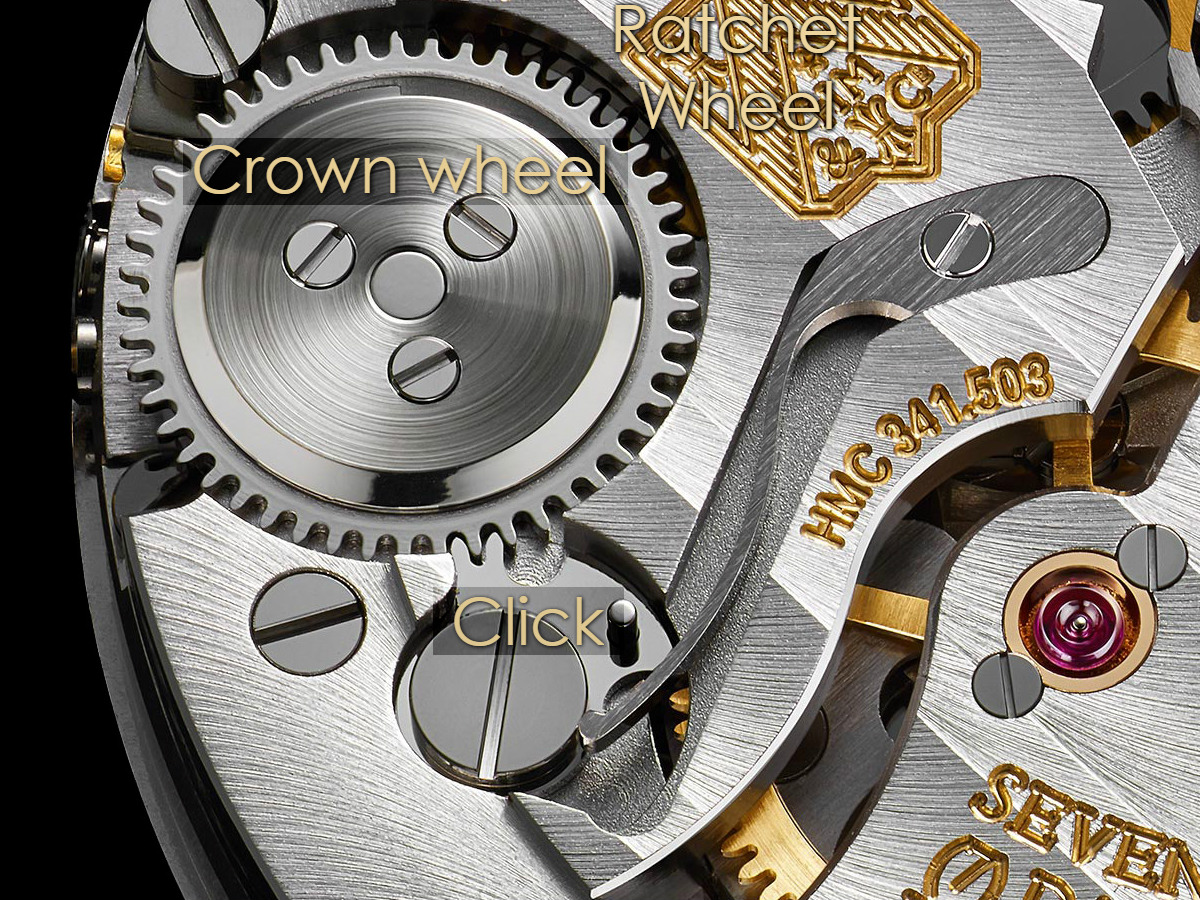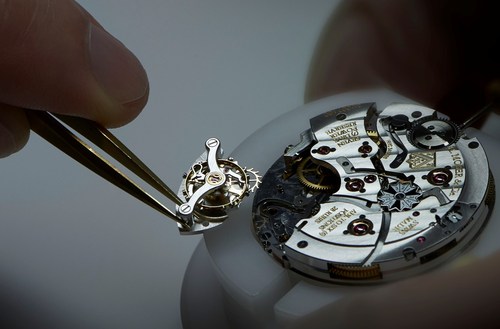
Today we are going to look at a complex mechanical watch movement and attempt to explain it simply. We focus on a few key components of the movement which are often mentioned. So the next time you read about a watch and its movement, you’ll know what they mean. The movement under the loupe is the Perpetual CalendarPerpetual Calendar A perpetual calendar is a complication in a mechanical watch that automatically adjusts for the different lengths of the months, including February, and leap years, and (almost) never requires manual adjustments. It has a mechanism that takes into account the different number of days in each month, including leap years, and automatically adjusts the date, day, month and year accordingly [Learn More] Calibre HMC 341 from H. Moser & Cie.
Power
The mainspringMainspring The mainspring is a spiral-shaped metal spring that stores energy in a mechanical watch movement. It is located inside the barrel. The mainspring is wound, either manually or automatically. The mainspring unwinds over time, and the watch will stop running when the mainspring is fully unwound. [Learn More] is where the watch gets all its power from. The main springMainspring The mainspring is a spiral-shaped metal spring that stores energy in a mechanical watch movement. It is located inside the barrel. The mainspring is wound, either manually or automatically. The mainspring unwinds over time, and the watch will stop running when the mainspring is fully unwound. [Learn More] is housed in what is called the barrelBarrel The barrel is a cylindrical container that holds the mainspring. The barrel is connected to the winding mechanism. The winding mechanism rotates the barrel, which in turn winds the mainspring. [Learn More] . In the background of the below picture you get a glimpse of parts of the gear train which is in connection with both the mainspring & escapementEscapement The escapement is a mechanism in a mechanical watch movement that regulates the release of energy from the mainspring and keeps the watch ticking at a steady rate. The escapement is made up of two main components: the escape wheel and the pallet fork. The escapement is responsible for the ticking sound of the watch, and it ensures that the watch runs at a consistent rate. As the escape wheel rotates forward, it locks and unlocks with the pallet fork, allowing a small amount of energy from the mainspring to be released. This causes the balance wheel to oscillate and the watch to 'tick'. [Learn More] (more on the latter below). The gear train constitutes more or less of the wheels & bits between the mainspring and the escapement module which make sure that the force of the mainspring is transferred to the balance wheelBalance Wheel The balance wheel is a component of a mechanical watch movement that oscillates at a consistent rate. It receives a small impulse from the pallet fork, which is part of the escapement mechanism. The balance wheel is connected to a hairspring that controls the rate of oscillation of the balance wheel. The balance wheel and hairspring work together to keep accurate time. The oscillations of the balance wheel drive the timekeeping functions of the watch. The balance wheel is a crucial component of a mechanical watch movement. [Learn More] and the hands turn to tell time:

Pictured above is a single barrel being placed on the mainplateMainplate The mainplate holds all the components of the watch movement together and forms the base of the watch movement. The mainplate is typically made of brass. It serves as the foundation for the movement, and all the gears, wheels, and other components are attached to it. It holds the jewels and pivots in place, and also serves as the base for the bridges and other structural components. [Learn More], the foundation of the movement. If more power is required you can have more than one barrel. In the case of the HMC341 you have a double barrel. And this leads to a whopping 7 day power reserveRéserve de marche Also known as Power Reserve. A watch's power reserve refers to the amount of time a mechanical watch can run without being wound. The power reserve of a mechanical watch can vary depending on the size of the mainspring, the efficiency of the gear train, and the rate at which the mainspring releases energy. If a watch has a Power Reserve 'complication' it simply means that the status of the power reserve can be seen on the watch itself (either on the dial or movement side of the watch). [Learn More]:

How you get the mainspring wound, and therefore powered up, is in this case by manually winding it at the crownCrown The knob on the outside of the watch that you typically use to either wind the mainspring or set the time [Learn More]. By rotating the crown, it’ll set in motion the crown wheelCrown Wheel The crown wheel is a gear that interacts with the crown. When the crown is turned, the crown wheel rotates and winds the mainspring. [Learn More] which will spin the ratchet wheelRatchet Wheel The ratchet wheel is another gear that is connected to the barrel. The ratchet wheel has a series of teeth that engage with a pawl, a lever that prevents the barrel from rotating in the opposite direction. The ratchet wheel allows the mainspring to be wound in one direction and prevents it from being unwound by accident, protecting the movement. The crown wheel and the ratchet wheel are important components of the winding mechanism that allow the watch to be wound and keep the energy needed for the movement to run. [Learn More] which tends to sit on top of the mainspring and as such will help coil it. To Avoid that the mainspring instantly uncoils itself, there’s a click which makes sure it can not unwind itself. It avoids that the crown wheel & therefore the linked up ratchet wheel & barrel can turn backwards under the mainspring’s tension:

When the click is pulled back, e.g. during servicing, the mainspring will unwind itself and the watch will remain without power.
Gotta keep it moving
There are a lot of moving parts in a watch movement, and where there is movement there is friction. In order to reduce friction you will find jewelJewels Watch jewels are small, synthetic sapphire or ruby bearings that are used in mechanical watches to reduce friction and wear on moving parts. They are typically made from corundum. They are used as bearings for a.o. the pivots to reduce friction. [Learn More] bearings in a movement. These are rubies in this particular case and they are cradled in ‘chatons‘:

With the chaton now set in place, a close-up follows of a ruby which is about to be nested in the chaton. The metal structure is the bridgeBridges The bridges of a watch movement are the metal plates that hold the wheels and other components of the movement in place. They are attached to the main plate of the movement with screws. Bridges are used to support the balance wheel, the escapement, the mainspring barrel and other elements. Combined with the main plate they are the foundation of any watch movement. [Learn More], but more on that below:

In the little hole of this ruby donut, a spindle will spin away and experience the least amount of friction possible:

Stay put
As briefly mentioned, the metal structure pictured above is called a bridge. A bridge is used to help secure parts to the mainplate. One watch movement can have multiple bridgesBridges The bridges of a watch movement are the metal plates that hold the wheels and other components of the movement in place. They are attached to the main plate of the movement with screws. Bridges are used to support the balance wheel, the escapement, the mainspring barrel and other elements. Combined with the main plate they are the foundation of any watch movement. [Learn More]:

Bridges & screws go hand in hand. Hereunder a close-up of the different types of screws you’ll find holding the calibre together:

We need a heartbeat
Once the power source & gear train is all set and secured, the “only” thing left is adding the escapement module to transfer all that power in actual accurate time. What the escapement does is translate that raw & unregulated power from the main-spring to that familiar tick-tock, in this case at a rate of 18,000 beats per hour.

The escapement wheel & pallet forkPallet Fork The pallet fork is a small lever in a mechanical watch movement that is part of the escapement mechanism. It is connected to the balance wheel and typically has two small, flat pieces called pallet jewels, which sit at the end of the pallet fork. These pallet jewels are also known as pallets. [Learn More] transfer the energy from the mainspring to the balance wheel at exact intervals. The pallet fork interacts with the balance wheel and the escapement wheel, this exact interaction is what creates that familiar ‘tick tock’ sound. The escapement wheel is the most Southern wheel in the below picture, it is the part of the escapement that touches the Gear train. The balance wheel is the wheel that rocks back and forth and cuddles the ever important hairspringHairspring The hairspring is a thin spring in a mechanical watch movement that is connected to the balance wheel. The balance wheel oscillates back and forth at a consistent rate, and the hairspring helps regulate these oscillations. The hairspring works by applying a restoring force to the balance wheel, which helps to keep the balance wheel oscillating at a consistent rate. The hairspring is also known as a balance spring. [Learn More], together they are the timekeeping element . Each swing of the balance wheel takes precisely the same amount of time. In a way, it acts much in the same way as the pendulum on old clocks which swing left & right. Overall, the escapement module is where art & science meet and consequently it gets really complicated and it consists of 59 parts in this case:

Worth mentioning at this point is the unique characteristic & approach that H. Moser & Cie has with respect to the escapement module. They call it their ‘interchangeable escapement module’. What they have done here is take into consideration how to efficiently make & best service a watch. As per Moser, their interchangeable escapement has been “developed to simplify the adjustment, cleaning and servicing of the watch. It enables the watchmaker to remove the existing escapement module, clean and oil the rest of the movement before installing a new pre-adjusted module.” This escapement module is designed to be easily installed & replaced during service when needed. Very clever indeed.
Et voila!
And finally when all is said and done, when the calibre is fully assembled, you’ll have this glorious movement staring back at you:

Photography note: Courtesy to @moserwatches for sharing the wonderful macro shots with the rest of us. Please respect their copyright. Sincere thanks to Olivier as well for making this happen, make sure to check him out on instagram here.



Very well explained about Mechanical Watches. I really like your blog and its images which you uploaded. Thanks for this informative blog.
Great to hear, thanks! It helps to have the wonderful Moser movement as model 😉